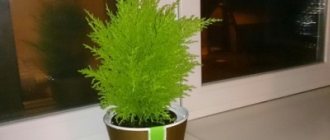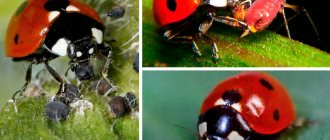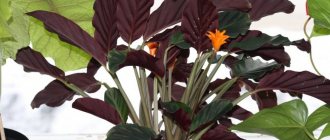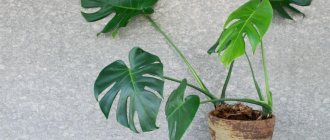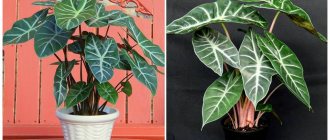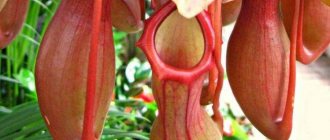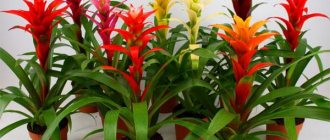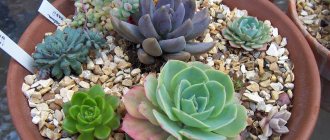Decoration of your home - cypress Goldcrest Wilma
Cypress is a favorite of landscape designers and gardeners. It combines two advantages - aesthetic beauty and usefulness.
Before growing this plant, read the recommendations for caring for it.
Let's talk about Gold Wilma cypress: care at home, problems with growing, beneficial and harmful properties.
Useful tips
The following recommendations will help ensure normal development and preserve the beauty and health of the flower at home.
- Yellowing of the cupressus indicates insufficient care, lack of nutrients, dry air, watering with very hard water (excess calcium forms in the soil). Increase plant feeding, watering and spraying.
- Exposure of the flower to direct sunlight will cause the leaves to yellow and fall off. It is necessary to move the plant to another place, more shaded and cooler.
- The tips of the leaves turn brown due to insufficient watering, dry or cold air.
- The twigs will begin to dry out if the cupressus is located near heating or heating devices. In this case, move the pot to another place and increase the number of sprays.
- Be sure to ensure that the flower does not freeze.
- In spring, prune dead branches. After pruning, lubricate the exposed bark with a special decoction.
Home care
This representative of evergreens and conifers takes root better than all others in apartment conditions. But he will not forgive you for inattention to himself !
How to care after purchase?
Cypress Goldcrest Wilma is very sensitive to external influences and lack of moisture . Do not loosen the soil under any circumstances to avoid damaging the roots.
Provide the plant with moderate air temperature in the remaining seasons of the year, and in winter – cool, 5 degrees.
From late spring to early autumn, it is better to place the cypress pot in fresh air, shading it and protecting it from drafts. The light should be bright and diffused. Do not destroy it with hot air from a radiator or heater during the rest period.
Features of watering
Water the plant on time. It is especially abundant from May to August inclusive. It is strictly forbidden to overdry it!
The reaction will occur only after some time - about a month. The cypress will turn pale, its branches will be dry and lifeless. But excess water is also harmful.
In winter , water several times a month at a temperature of 8-9 degrees, and once a week at 10-12.
Feel free to spray more often, maybe even daily.
Bloom
At home, Goldcrest Wilma cypress has almost no chance of blooming . This is due to the fact that unisexual male plants usually go on sale.
any big hits from him either. Cypress is dioecious in nature - for the formation of cones it is necessary to have both sexes of the plant - male and female.
Crown formation
By nature, Goldcrest Vilma is endowed with harmony and grace, correctness of form. First of all, this concerns the crown. It can be trimmed and adjusted occasionally. thorough pruning in the spring , before active sap flow begins.
It is useful to form a crown and trim it to give the plant a well-groomed appearance and activate the growth of young shoots. If you prefer classic forms, one procedure a year is enough. The tree will stretch upward, the growth of side shoots will remain slow, and the crown will form naturally.
If you wish, you can give the cypress an accent that is in tune with the overall interior of the home and your preferences. Fragile branches are easy to trim and “sculpting” the crown is not difficult. It’s quite easy to design the branches in the form of a cube, ball, pyramid, spiral to suit your imagination.
Preparing the soil and soil
Options:
- the pH level for soil for cultivation should be in the range of 5.5-6.5;
- a slightly acidic environment is most favorable;
- we select the soil in the ratio: one part turf soil, two parts leaf soil, one part peat soil and one part sand;
- We prepare high-quality drainage with the obligatory admixture of expanded clay, and make several holes at the bottom of the pot.
Planting and transplanting
If you want to plant a young sprout in a pot, do so when it reaches at least one month of age.
Do not immerse the root collar deep into the ground so that the plant does not die. The root collar is figuratively called the boundary that divides the trunk into aboveground and underground.
Reproduction
Amateur gardeners often purchase cypress seedlings in specialized stores. It is propagated mainly by breeders and people who grow the crop for sale. There are three propagation options: seeds, cuttings and layering.
Seeds
Propagation from seeds is used mainly in breeding work (for domestication of wild species). At home, it is possible to propagate cypress trees by seeds, but valuable varietal characteristics may be lost.
The first stage of propagation by seeds is the process of collecting seed material and properly drying it. To obtain uniform shoots, seed stratification is carried out (imitation of weather conditions). To do this, the seeds are sown in a moist soil substrate, after which the containers are taken outside and immersed in snow for the winter.
In the spring, they are brought into a warm place, waiting for germination, after which they provide abundant watering and, if necessary, dive. When the seedlings become stronger, they are taken out into fresh air for hardening. In April, with the onset of warmth, they are planted in open ground.
Cuttings
Cuttings are the most reliable method often used in home breeding. First, cuttings are prepared by cutting them from shoots 10 to 15 cm long (for columnar and spherical varieties, vertically growing stems are taken on the trunk, for creeping ones, lateral ones). The lower part is freed from the needles and planted in containers for rooting, having previously been dipped in a solution of a growth stimulator. Cover the top with plastic film, making it look like a greenhouse. High humidity promotes rapid rooting of cuttings.
After about 3 months, when small roots appear, remove the polyethylene and wait for the roots to develop. In 2 months they will reach a sufficient size and it will be possible to plant them in open ground. This must be done in the warm season, after hardening the plant.
Layerings
Reproduction by layering is possible if the cypress tree has creeping shoots. To do this, in the spring, choose the lower powerful stem. A shallow incision is made on it, into which a small pebble is placed, preventing it from overgrowing. The selected shoot is laid on the ground, fixed and the incision site is sprinkled with earth. Actively water it together with the parent plant. These actions help ensure that a young root system begins to develop at the incision site. Then the shoot is cut off from the tree, the young root is carefully dug out and transplanted to a permanent place before the beginning of the growing season.
Benefits and harms
There is a lot of talk about the beneficial and harmful properties of Goldcrest Wilma cypress. Let's start with the useful ones :
- extraction of essential oil used for aromatherapy, for respiratory diseases and for a beneficial effect on the female body, treating edema, normalizing mood and combating stress;
- tincture of cones is used in folk medicine for inflammatory processes and bleeding;
- needles have a good effect on the nervous system and the respiratory system, producing oxygen and harmonizing the microclimate in the house;
- The wood has a fungicidal effect - it repels small insects.
First steps after purchase
Cupressus is transshipped immediately after acquisition. By the time the plant appears in the house, it is advisable to prepare a suitable container and substrate.
Cypress is harmed by sudden changes in temperature, lighting level and air humidity. If you plan to place the purchased plant in conditions different from previous ones, you need to accustom it to the new regime gradually.
IN THE PHOTO: To get 100% healthy plants, you should order young Cypress trees from nurseries, botanical gardens or trusted specialized stores.
To improve the health of Kupressus, it is treated with the fungicide Fitosporin-M. Preventive treatment with Fitoverm will protect against sudden pest damage.
Scientific name
Cupressus Goldcrest Wilma is the scientific name for the type of cypress we are considering. The first word comes from the island of Cyprus, the birthplace of the evergreen plant. Its leaves are cross-paired - hence the second part of the name.
These photographs show all the beauty of this type of cypress.
Who should not use cypress as a medicine?
The use of cypress allows you to get rid of many pathologies. However, the plant cannot be used in some cases. The main limitation to use is considered allergies. In addition, doctors do not recommend taking oils and herbal medicine during pregnancy, breastfeeding and small children. Cypress should also not be used if there is an increased risk of blood clots or with heart pathologies. The plant should not be used in children and women with mastopathy.
Care and maintenance of Goldcrest Wilma cypress
The Goldcrest Wilma cypress has gained particular love among flower growers. In Latin, “cypress” sounds like “Cupressus”, that is, “kupressus”, therefore the use of both names is equally valid.
Indoor cypress was bred in Britain to be kept in offices, but quickly gained the love of gardeners around the world.
Cypress Goldcrest Wilma belongs to the cypress family and looks like a Christmas tree with narrow leaves, only in miniature. The shoots are light green, almost yellow, which is why this plant is sometimes called “golden”. The small scaly leaves emit a faint lemon aroma. The variety was bred on the islands of Foggy Albion specifically for indoor growing and became the most popular office plant there.
Spreading
Cypress trees in the wild grow in subtropical and tropical temperatures. Plants are heat-loving, so wild crops do not live in temperate climates. However, today several indoor varieties and hybrids have been bred and are actively grown in northern latitudes.
The habitat is considered to be North America, the Caucasus, the Sahara and the Himalayas. Wild specimens are native to China and Oregon. You can also grow wild cypress trees in Russia - in Crimea and Sevastopol. The plant's habitat is the Mediterranean. The cultures are found throughout Syria and Libya. Hybrid varieties are grown everywhere.
Cypress trees are heat-loving crops that grow in the wild along the edges of rivers and coastal areas. The plant is cultivated in the form of alleys, as well as individual ornamental trees. The crop is not picky about the soil; fertility and a sufficient amount of nutrients are not important for it.
Care requirements
- Lighting. Cypress Goldcrest Wilma prefers indirect light. If there is too much light, it may crumble. In winter, if there is a lack of natural lighting, it is necessary to organize artificial lighting, since if there is a lack of light, the shoots will stretch out and the cypress will lose its decorative appearance.
- Temperature. Loves moderate temperatures. At temperatures above 27°C, the cypress will begin to dry out and crumble. In summer you can keep it outside, protecting it from the sun and drafts. In winter, the temperature should be approximately 8-10°C. Under no circumstances should you place a flower near batteries.
- Watering. In spring and autumn, cypress needs abundant watering. In winter, when the temperature drops, watering is reduced. Depending on the temperature conditions of the room, the plant’s soil should not be allowed to dry out or become waterlogged. Cypress naturally grows near bodies of water, so it prefers moist air. To do this, the tree must be sprayed regularly. If the plant is kept outside in the summer, then during the hottest days you can water it with warm water from a watering can several times a day.
- The soil. The easiest way is to purchase ready-made soil for coniferous plants. To prevent root rot, cypress requires good drainage.
- Feeding. Conventional complex fertilizers are not suitable for this plant. They might just burn the cypress. Therefore, in order not to take risks, it is better not to use any fertilizers.
- Transfer. Cypress Goldcrest Wilma is replanted only if there is a strong need in early spring. It has very delicate roots, and any replanting is stressful for the plant. If possible, you can simply replace the top layer of soil without damaging the root system. When replanting, the root collar should not be buried, otherwise the tree may die. In order to replant cypress as rarely as possible, some gardeners slow down its growth by pruning the roots during the next replanting.
- Trimming. To form a crown in the spring, cypress must be pruned. This procedure stimulates the development of new branches.
How to grow indoor cypress
Homemade cypress in a pot looks very attractive. Green sculptures add a special sophistication to room design.
Houses contain large-fruited cypress; it forms small trees, sometimes reaching two meters in height.
There is another plant that is mistakenly called indoor cypress due to its great external similarity. This is Elwoody cypress. Breeders have developed different varieties for indoor use.
Conifers are quite difficult to grow at home. To do this, a number of conditions must be met.
How to care for cypress indoors
- Lighting is diffused, avoid direct sunlight.
- Special soil for coniferous plants.
- Good drainage is a must.
- Regular watering, without stagnant water.
- Feeding with special fertilizer.
- In winter, it is advisable for the plant to create cooler conditions, about +15 C.
Correct transplant
Plants suffer from root damage quite painfully, so replanting is carried out under certain conditions.
- The procedure is carried out in the spring, after leaving the dormant state.
- The new pot is 3–4 cm larger than the previous one.
- The flower is taken out with a lump of earth, and planted with it in a new container. The top layer of soil is removed. Then all voids are filled with fresh soil.
- Water generously and shade from the sun.
Propagation of Goldcrest Wilma cypress by seeds and cuttings
Appearance of branches of plants of the cypress family.
- Use of seeds. This type of propagation is used in the spring, when the green cones have already opened. Up to 30 seeds ripen in each of them. They must be planted in a moist substrate and placed in a shaded place until germination. The germination rate of cypress seeds is very low. About 7-10 seeds will hatch from one cone. After the sprouts appear, the container must be moved to a lighted place. Caring for them involves moderate watering. After a month, young cypress trees can be planted in separate pots.
- Using cuttings. This method can be used in spring and autumn. To do this, it is necessary to cut off the lignified cuttings and root them in a moist substrate.
Cypress propagation
The crop can be propagated generatively by sowing seeds in the spring or vegetatively by cuttings. The second method is most often used. Cuttings taken at the transitional stage of foliage take root faster. The procedure can be carried out from mid-autumn to late spring.
For propagation, take 15 cm cuttings of the current season, woody at the base and green at the top; it is advisable to cut them with a “heel” or at an angle of 45 degrees.
Then the leaves are removed from the bottom of the cutting, as they may rot when planted in a damp substrate. Place a drainage layer of expanded clay in the pot and fill it with a mixture of peat moss and perlite (2:1) or universal soil with sand (2:1). Both mixtures are suitable.
When using a root growth stimulating hormone, first dip the tip of the cutting in water, blot thoroughly, dip the cut 5 cm into the powder, and then bury it in the prepared substrate.
The pots with cuttings are covered with a transparent bag, which will provide greenhouse conditions, and placed in a warm place (20-22 ̊C) in bright, diffused sunlight.
Check the soil regularly - it should always be moderately moist. Once a week, to prevent the appearance of mold and other fungal diseases, water with water containing a fungicide. Once every 2-3 days, the leaves are lightly sprayed with rain or melt water at room temperature.
The rooting process usually takes 3 months, but sometimes this period is longer. If there are signs of development of the root system, then the package is removed, and the seedlings will be ready for planting after another 2 months, when the roots are already visible from the drainage holes.
In any case, transplanting a cypress tree into open ground is carried out in warm weather after an adaptation period - take the pot out into the open air and place it in the shade for several days, then in partial shade, and so on.
Growing from seeds
After collection, the shifts are given a “wintering” - stratification. To do this, they are kept in the refrigerator for several months, then soaked before planting.
Sowing is done in a special soil mixture for conifers. Shoots appear in a month. Since the seedlings grow slowly, for the first 1 - 3 years they are grown at home, like an indoor flower. For the winter, it is advisable to arrange a “wintering”, maintaining a cool air temperature.
Cuttings
Cuttings are the most reliable method often used in home breeding. First, cuttings are prepared by cutting them from shoots 10 to 15 cm long (for columnar and spherical varieties, vertically growing stems are taken on the trunk, for creeping ones, lateral ones). The lower part is freed from the needles and planted in containers for rooting, having previously been dipped in a solution of a growth stimulator. Cover the top with plastic film, making it look like a greenhouse. High humidity promotes rapid rooting of cuttings.
Layerings
Reproduction by layering is possible if the cypress tree has creeping shoots. To do this, in the spring, choose the lower powerful stem. A shallow incision is made on it, into which a small pebble is placed, preventing it from overgrowing. The selected shoot is laid on the ground, fixed and the incision site is sprinkled with earth. Actively water it together with the parent plant. These actions help ensure that a young root system begins to develop at the incision site. Then the shoot is cut off from the tree, the young root is carefully dug out and transplanted to a permanent place before the beginning of the growing season.
Diseases and pests
Goldcrest Wilma cypress is most often affected by scale insects and spider mites. In this case, the plant must be treated with drugs.
Cypress is quite resistant to diseases. If they occur, it means that the containment conditions have been violated. When overwatered, the tree is affected by various types of rot. With dry air, lack of light or water, the plant begins to dry out.
Monitor your pet regularly and at the slightest sign of disease, achieve comfortable conditions for growing cypress.
This interesting plant requires proper care, but attention and care will reward you not only with its spectacular appearance.
Cypress is able to saturate the air with essential oils that destroy pathogenic microbes.
It has a beneficial effect on the respiratory system, saturating the air with purified oxygen. This evergreen tree can not only create coziness, but also become a real family healer.
Possible problems
Indoor roisissus is undemanding in terms of care and living conditions, and is also resistant to disease. However, if the rules of care are violated, the following problems may arise:
- Brown spots on the foliage. These are burns left by the scorching rays of the sun. Remember that at midday the bush needs protection from sunlight.
- Shrinking of foliage and stretching of stems. The bush stands in an excessively dark place. Choose a more suitable and bright place for it.
- Yellowing of leaf blades. This may be due to the fact that the plant is experiencing an acute lack of nutrients. This problem also occurs when watering is improper. Roicissus must be fed regularly and do not forget to water it in a timely manner.
- Drying of the tips of the foliage. The air in the room is very dry. Provide the bush with timely moistening of the leaves from a spray bottle.
- Pests. Most often, mealybugs, whiteflies, spider mites and aphids settle on such indoor crops. In order to get rid of pests, the plant is treated with an insecticide solution.
Benefits and harms
There is a lot of talk about the beneficial and harmful properties of Goldcrest Wilma cypress. Let's start with the useful ones :
- extraction of essential oil used for aromatherapy, for respiratory diseases and for a beneficial effect on the female body, treating edema, normalizing mood and combating stress;
- tincture of cones is used in folk medicine for inflammatory processes and bleeding;
- needles have a good effect on the nervous system and the respiratory system, producing oxygen and harmonizing the microclimate in the house;
- The wood has a fungicidal effect - it repels small insects.
Cypress is harmful for those who suffer from high blood pressure or have epilepsy.
Cupressus beneficial properties. Useful properties of cypress
What beneficial, medicinal properties does cypress have? Cypress energy. What are the benefits of cypress? Healing properties of cypress.
Cypress belongs to the cypress family, which has significant differences from other representatives of conifers. They are highly drought-resistant, love dark places, do not require good soil, grow slowly, but have a long life expectancy.
Cypress leaves resemble fern leaves, bright green in color. Some varieties of cypress can have golden yellow leaves. The cypress trunk is very slender.
Cypress is native to the Mediterranean and is grown in Spain, France and Morocco. Cypress is a symbol of life after death. From Latin its name Sempervirens translates as “evergreen”.
They started growing cypress indoors relatively recently; Previously, like other conifers, it was not very popular among gardeners. Now some types of cypress and cedar are used as indoor plants. For example, a type of cypress such as large-fruited cypress, which is specially bred for keeping in apartments, is distinguished by its small size. Indoor cypress requires coolness and infrequent watering. It is better to place it on the eastern and northern windows. In winter, the cypress can be placed on the south or west side, but closer to summer it should be moved to a darker place or artificially shaded.
Cypress is highly valued for its essential oil, which has a warm, spicy aroma with sweet, woody and smoky undertones. The oil is extracted by steam distillation from round cones; shoots and pine needles are also used for this.
Cypress has long been used in folk medicine in many countries. Its oil has a beneficial effect on the female body, helping regulate female hormones during menstruation and menopause. The antispasmodic effect determines the use of cypress oil for bronchial asthma, bronchitis and whooping cough. Cypress oil is also used to treat varicose veins and eliminate swelling.
Cypress oil is recommended for restless people who are unable to spend even a minute without moving. It calms, fights stress, gives a good mood. Cypress oil is contraindicated for people suffering from high blood pressure and epilepsy.
For bleeding gums and nosebleeds, as well as excessive sweating, cypress oil is also used. It is widely used in the perfume industry as it has a pleasant woody aroma. Cypress oil can be combined with essential oils of myrtle, nutmeg, bergamot, lemon, orange, sage and lavender.
Cypress needles have healing properties; they have a beneficial effect on the respiratory and nervous systems, produce oxygen and help improve the microclimate in the apartment.
Aromatherapy with cypress oil
Ingredients: 4 drops of cypress oil.
Method of preparation: add oil to the aroma lamp.
Directions for use: light a lamp in the evening or at night to calm the body. It also helps to drive insects out of the apartment.
Bath with cypress oil for excessive sweating of the feet
Ingredients: 3 drops of cypress oil.
Method of preparation: take water into a bowl and add cypress oil to it.
Directions for use: Take foot baths every evening.
Inhalation with cypress oil for night coughing
Ingredients: 2-3 drops of cypress oil.
Method of preparation: drop oil on a handkerchief.
Directions for use: place the scarf on the pillow and sleep on it, inhaling the aroma.
Rubbing with cypress oil for acne and oily skin
Ingredients: equal parts of cypress oil, cedar oil and juniper oil.
Method of preparation: mix ingredients.
Directions for use: Wipe problem skin with the resulting mixture once a day.
Note: helps against eczema, regulates sebum production and helps cleanse the blood.
Massage mixture with cypress oil
Ingredients: 5 drops of cypress oil, 4 drops of juniper oil, 3 drops of rosemary oil, 30 ml of almond oil, 20 ml of rosehip oil.
Method of preparation: mix all ingredients.
Directions for use: massage with the resulting oil once a day.
Note: cypress oil strengthens ligaments and joints well.
Tincture of cypress cones for uterine bleeding
Ingredients: 20 g of unripe cypress cones, 250 ml of 70% ethyl alcohol.
Method of preparation: grind cypress cones, add alcohol, leave in a dark place for 2 weeks, shake every day, then strain.
Directions for use: drink 10-12 drops of tincture in the morning on an empty stomach and in the evening before bed, with a small amount of water.
Similar articles:
New Year's Magic
Eriobothrya. Beneficial and healing properties of eriobothria
Medicinal and beneficial properties of thyme
I'm tired of coughing. What to do?
Planting and caring for cypress (in brief)
- Flowering: decorative deciduous plant.
- Lighting: in the morning - bright diffused light, in the afternoon - partial shade (eastern and northern window sills).
- Temperature: 20-24 ˚C in summer and 5-15 ˚C in winter.
- Watering: regular, moderate in summer, scanty (once a week) in winter.
- Humidity: normal for residential premises.
- Fertilizing: in the spring-summer period - once a month with mineral fertilizers in a concentration twice as weak as recommended.
- Replanting: once every two years in April or May.
- Reproduction: seeds and cuttings.
- Pests: scale insects, false scale insects and spider mites.
- Diseases: due to improper maintenance and care, the needles turn yellow and dull, the branches dry out, and sometimes root rot develops.
How to control pests
Insects rarely attack cypress trees, since the sap of coniferous plants is unattractive to them. There are only two types of parasites that primarily attack shrubs:
- Spider mites are small green bugs that weave webs throughout the plant. This is the main sign of infection.
- Scale is a pest covered with a waxy natural “shield” that is very dangerous for any plant, since getting rid of it is quite problematic.
In both cases, the tree will begin to wither, dry out and become dull. Cypress trees are treated for parasites by spraying with insecticide and acaricide. It would not be superfluous to trim off heavily damaged areas and wash the crown in the shower, covering the soil with polyethylene. Be sure to quarantine the plant for the period of treatment - away from other representatives of the flora.
What is cupressus
An evergreen plant belonging to the cypress family is called cupressus, cypress or cypress. O This is a tree with wrinkled bark, the shade of which varies from dark gray to brown. The branches on a very slender trunk are located in the same plane; adult plants have scaly needles, while young plants have very soft, small needles. Cypress can grow up to several meters in height.
Most often, cupressus is used as a landscape decoration in a country house or garden plot - the tree fits perfectly into the composition of alpine hills and flower beds. It can simply decorate the entrance or replace the New Year tree. Cypress can be planted in open ground and decorative pots.
Transplanting cupressus at the dacha into open ground
Before transplanting cupressus into a pot or open ground, it is necessary to feed the plant and provide it with the most comfortable conditions for the development of the root system.
After purchasing a young cupressus plant in a store, it can be replanted after about a month, during which time it adapts to new conditions. To make this time useful, during this period the pot is placed in a cool place with good lighting. Within 3-4 months, with moderate watering, the plant completely adapts to indoor conditions, after which it can be transplanted into a larger pot or open ground.
It is recommended to replant young cupressus plants in the country no more than once a year. This is done in the spring, before the start of active growing season. The root system does not survive transplantation very well; it is not freed from the earthen coma. The cupressus is transplanted into a new container using the transfer method, adding soil for coniferous indoor plants.
Cupressus can be replanted in open ground in the spring, provided that the cold does not return. This is done in two ways - in a container and without it. Without a container, the root system may grow wider, which makes it difficult to dig it up for the winter without damage. For planting, a hole is dug, 70 cm deep, and a thick drainage layer of broken brick, pebbles or expanded clay is laid on its bottom. If you decide to grow several specimens at your dacha, then the distance between plantings of cupressus should be at least 2 meters, according to the pattern that can be seen in the photo below.
Soil for cupressus, dug out of a hole, must be mixed with a small amount of humus and sand to create a nutritious and light soil. In the center of the hole we lay out a small mound of soil and place a lump with the root system on it, then carefully cover the seedling with soil. Instead of humus, you can use special organomineral fertilizers of prolonged action
When planting cupressus in the garden, it is important to ensure that the root collar is above ground level.
Types and varieties of cypress
More recently, it was believed that cypress trees cannot be grown in ordinary housing, but there were flower growers who refuted this misconception. Conifers are increasingly becoming inhabitants of city apartments, not to mention the fact that in private houses with extensive galleries and terraces, cypress trees are one of the most popular living decorative elements. We will present to you the most famous species of the cypress genus, grown as indoor plants.
Arizona cypress (Cupressus arizonica)
A light-loving and drought-resistant species, reaching a height of 15 m in nature. The bark of young shoots is gray, old shoots are dark brown, peeling off over time. The leaves are finely pointed and gray-green in color.
Evergreen cypress (Cupressus sempervirens)
In the wild, only the horizontal form of this species is widespread. Drought-resistant, cold-resistant (if we are talking about short-term cold spells). The crown is pyramidal, the branches are short, ascending, tightly pressed to the trunk. Does not tolerate excess moisture. It has high decorative qualities and is widely used in garden design and indoor decoration. It has two widely used varieties in culture:
- pyramidal cypress (f. pyramidalis, f. stricta) - with a very dense narrow pyramidal crown of ascending branches pressed to the trunk. The needles are arranged crosswise and pressed tightly against the shoots. The cones are round, 2-3 cm in diameter, similar to a small soccer ball;
- horizontal cypress (f. horisontalis) - its branches extend vertically from the trunk, and then rise upward, due to which a wide pyramidal crown is formed.
Lusitanian cypress or Mexican cypress (Cupressus lusitanica)
It is distinguished by a wide pyramidal crown and hanging branches. The bark is red-brown, the branches are tetrahedral. Sensitive to cold, does not tolerate dry soil and air, has many decorative forms:
- Bentham form (Benthamii) - the shoots branch in the same plane, and the needles have different shades - from lush green to bluish, the crown is narrow and regular in shape;
- blue form (glauca) - a variety with needles of a bluish hue and a coating of the same color on the cones;
- sad form (tristis) – columnar crown, flexible branches directed downwards;
- Knight's form (Nightiana) - similar to Bentham's form, but the needles are gray.
Cashmere cypress (Cupressus cashmeriana)
Brought from India, it is very demanding on air and soil humidity, but grows well in indoor conditions.
Large-fruited cypress (Cupressus macrocarpa)
The species most adapted to growing indoors. The crown is pyramidal, the trunk is erect, numerous branches extending horizontally from the trunk are covered with small scales of light or dark green leaves. The lower branches of large-fruited cypress are darker than the upper ones, the cones are 3.8 cm in diameter.
Botanical description
It is represented by a plant with an evergreen crown, growing in the form of shrubs and trees. Cypress trees are members of the Cypress family. The crop, depending on the variety, takes on different crown shapes - spreading or even. It is considered a century-old tree, since the lifespan of individual individuals can exceed three centuries. The height of cypress trees can exceed 25 m, while shrubs grow up to 2 meters. Tree growth activity is observed in the first years of life; adult plants grow slowly.
The roots are spreading and dense. The rhizome lies to a depth of 2 meters in the ground. Young individuals have a small rhizome with an abundance of adventitious roots. The diameter of the main roots of an adult cypress reaches 15 cm. The roots are light inside, covered with a brown layer on top.
Depending on the form of growth, cypress may have one trunk or several stems growing from the base of the rhizome. The trunk can be erect or curved, covered with gray-brown bark. The bark of young plants is smooth, lighter than that of adult plants. With age, the trunks darken and develop vertical cracks on the stems and trunk. The tree trunk is about 1 meter in diameter, but there are patriarchs with a diameter exceeding 5 meters. At a distance of about a meter from the base, additional branches extend from the trunk. The trees have a variety of shapes - from pyramidal to spreading weeping. The branches decrease in size as they reach the top. The diameter of the crown at the bottom of the tree can reach 5 meters, and at the top it is about a meter. The branches are fluffy, covered with smaller branches and shoots.
The stems of the shrubs are dark brown in color and covered with smooth bark. Shrubs have several stems. The branches are spreading and have an abundance of accessory branches and stems. The branches are covered with small scales, giving the bush volume. The stems are covered with smaller branches, densely covering the entire bush.
Over the entire surface, the cypress is densely covered with a green crown, consisting of many needles. Needles are needle-like leaves that cover every branch and shoot of the plant. Young trees have needle-like leaves that darken and become scaly over time. The leaves of mature cypress trees are pressed against the branches, forming a dense surface. There is a groove visible on the outer part of the leaves, which is an oil gland. The color of the leaves is green or green-blue. The leaves of the bush are embossed and quite long. The length of the thin plate can exceed 5 cm. On the stems, soft needles are supported by a modified petiole, which forms part of a leaf narrowed at the base. The peculiarity is that the leaves can be divided into several parts.
In spring, male and female cones appear on the plant. The culture is monoecious, with fruits of different sexes appearing in different parts of the cypress. male cones - microstrobiles, are small growths hanging down from the shoots. At the end of the male cone there is a spore-bearing leaf. Males are arranged in several units. The females are located close to the males so that pollination can take place. The female cones are much larger and are attached to the stem with a small rod. The cones are scaly, under the top layer the seeds are tightly pressed to the center. An unripe cone is tightly sealed, but as it ripens, it opens and scatters nuts throughout the area. The shape of female cones is ovoid, color is brown.
Growing
Monterey cypress is widely cultivated away from its native range, both in other locations along the California coast and in other areas with similar cool summers and mild winter oceanic climates. It is a popular private garden and public landscape tree in California.
When planted in areas with hot summers, such as inland California away from coastal fog zones, Monterey cypress has proven to be very susceptible to cypress cankers caused by the fungus Seiridium cardinale
, and rarely survives more than a few years. This disease is not a problem where summers are cool.[16]
A number of cultivars have been selected for use in the garden, including Goldcrest with yellow-green, semi-leaf foliage (with spreading tips of scaly leaves) and Lutea with yellow-green foliage. Goldcrest received the Royal Horticultural Society's Award of Lifetime Achievement in Gardening[17] (confirmed 2022).[18]
Monterey cypress is one of the parents of the fast-growing cultural hybrid Leyland cypress, Cupressus
×
Leylandii
, another parent of Nootka cypress,
Cupressus nootkatensis
.[7]
The foliage is slightly toxic to livestock and can cause abortions in cattle.[19] Sawn logs are used by many craftsmen, some boatbuilders and small manufacturers as a construction material for furniture and decorative wood because of its beautiful colors. It is also a fast-burning firewood, although it is sparkling (and therefore not suitable for open fires).
In Australia and New Zealand, Monterey cypress is most often grown on farms as a windbreak tree, usually in rows or shelters. In New Zealand it is also planted as an ornamental tree and sometimes as a timber tree. There, finding more favorable growing conditions than in its native range, and in the absence of many native pathogens, it often grows much larger, with trees recorded over 40 m (130 ft) tall and 3 m (9.8 ft) tall. in trunk diameter. .[5][7] One specimen - with a trunk diameter of more than 4.6 m (15 ft) - is considered perhaps the largest in the world.[20] Monterey cypress wood was used to make fence posts on New Zealand farms. electric fencing has become popular.
Cupressus macrocarpa
varieties grown in New Zealand:[21]
- 'Aurea Saligna' - long cascades of weeping golden-yellow thread-like foliage on a pyramidal tree.
- 'Brunniana Aurea' has a columnar or conical shape with soft, rich golden foliage.
- 'Gold Rocket' is a narrow, upright, golden-colored, slow-growing form.
- 'Golden Pillar' is a compact, conical tree with dense yellow shoots and foliage.
- 'Greenstead Magnificent' is a dwarf form with blue-green foliage.
- 'Lambertiana Aurea' is a hardy upright form that tolerates poor soil and climatic conditions.
Distribution
Two native cypress forest stands are protected, inside Point Lobos State Forest and Del Monte Forest. This natural habitat has cool, wet summers and is almost constantly washed by water. sea fog.[5][6]
The species has been planted widely outside its native range, especially along the California and Oregon coasts. Its European distribution includes Great Britain (including the Isle of Man and the Channel Islands), France, Ireland, Greece, Italy, Portugal and Sicily.[15] In New Zealand, plantings are naturalized, finding conditions there more favorable than in their native range. It has also been grown experimentally as a forest crop in Kenya.[5][7]
Cupressus macrocarpa
also grown in South Africa.[
citation needed
] For example, a grove was planted in memory of the South African infantrymen who died fighting for the Allies in Italy and North Africa during World War II.
As in California, the trees of the Cape are gnarled, windy and very beautiful. Trees with typical wind sculpture in his native area
